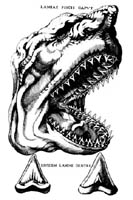

Despite a relatively brief scientific career, Nicholas Steno's work on the formation of rock layers and the fossils they contain was crucial to the development of modern geology. The principles he stated continue to be used today by geologists and paleontologists.
Steno was born as Niels Stensen, but he is better known by the Latinized forms of his name, Nicholas Stenonis or Nicholas Steno. A native of Copenhagen, Denmark, Steno left Denmark in 1660 to study medicine at the leading center for medical education of his time, the University of Leiden in the Netherlands. After brief stints in Paris and Montpelier, he moved to Florence, Italy in 1665. His studies in anatomy attracted the attention of the Grand Duke of Tuscany, Ferdinand II, who was also a patron of the sciences. Duke Ferdinand appointed Steno to a hospital post that left him ample time for his research. Steno was also elected to the Accademia del Cimento (Experimental Academy), a body of researchers inspired by Galileo's experimental and mathematical approach to science.
 Steno's anatomical studies focused at first on the muscular system and the nature of muscle
contraction -- for example, he used geometry to show that a contracting muscle changes
its shape but not its volume. However, in October 1666, two fishermen caught a huge shark
near the town of Livorno, and Duke Ferdinand ordered its head to be sent to Steno. Steno
dissected it and published his findings in 1667. The figure at right shows the figure
published by Steno of the shark's head and teeth (click on it to view a larger version).
While examining the teeth of the shark, Steno was struck by their resemblance
to certain stony objects, called glossopetrae or "tongue stones," that were found
in certain rocks. Ancient authorities, such as the Roman author Pliny the Elder, had
suggested that these stones fell from the sky or from the moon. Others were of the
opinion, also going back to ancient times, that fossils naturally grew in the rocks.
Steno's contemporary Athanasius Kircher, for example, attributed fossils to a
"lapidifying virtue diffused through the whole body of the geocosm." Steno, however,
argued that glossopetrae looked like shark teeth because they were shark
teeth, that had come from the mouths of once-living sharks, and come to be
buried in mud or sand that was now dry land. There were differences in composition
between glossopetrae and living sharks' teeth, but Steno used the
"corpuscular theory of matter", a forerunner of atomic theory, to argue that fossils could
be altered in chemical composition without changing their form.
Steno's anatomical studies focused at first on the muscular system and the nature of muscle
contraction -- for example, he used geometry to show that a contracting muscle changes
its shape but not its volume. However, in October 1666, two fishermen caught a huge shark
near the town of Livorno, and Duke Ferdinand ordered its head to be sent to Steno. Steno
dissected it and published his findings in 1667. The figure at right shows the figure
published by Steno of the shark's head and teeth (click on it to view a larger version).
While examining the teeth of the shark, Steno was struck by their resemblance
to certain stony objects, called glossopetrae or "tongue stones," that were found
in certain rocks. Ancient authorities, such as the Roman author Pliny the Elder, had
suggested that these stones fell from the sky or from the moon. Others were of the
opinion, also going back to ancient times, that fossils naturally grew in the rocks.
Steno's contemporary Athanasius Kircher, for example, attributed fossils to a
"lapidifying virtue diffused through the whole body of the geocosm." Steno, however,
argued that glossopetrae looked like shark teeth because they were shark
teeth, that had come from the mouths of once-living sharks, and come to be
buried in mud or sand that was now dry land. There were differences in composition
between glossopetrae and living sharks' teeth, but Steno used the
"corpuscular theory of matter", a forerunner of atomic theory, to argue that fossils could
be altered in chemical composition without changing their form.
Steno's conclusion may seem so blatantly obvious as to be insignificant. Furthermore, Steno was not the first person to link "tongue stones" with sharks' teeth. Steno's contemporaries Robert Hooke and John Ray also argued that fossils were the remains of once-living organisms. The Italian naturalist Fabio Colonna had stated that "tongue stones" were shark teeth in a book published in 1616, and others had noticed the similarity even earlier. However, it is important to remember that shark teeth, and some other fossils such as relatively young clams and snails, are "easy fossils" -- they resemble living organisms very closely. A great many fossils do not look like familiar living organisms at all. They may be preserved in an unusual way; they may represent only a part or fragment of an organism; they may belong to extinct taxa; and/or their living counterparts may be unfamiliar or unknown. In Steno's time, in fact, the word "fossil" could mean virtually anything dug from the Earth. Naturalists did not always distinguish between "fossils" that resembled living organisms, and "fossils" such as crystals and ores that did form within the Earth. For all these reasons, the distinction between which objects found in rocks were and were not once-living organisms -- if, indeed, any of them were -- was not at all obvious in the seventeenth century.
Steno's work on shark teeth led him to the more general question of how any solid object could come to be found inside another solid object, such as a rock or a layer of rock. The "solid bodies within solids" that attracted Steno's interest included, not only fossils as we would define them today, but minerals, crystals, incrustations, veins, and even entire rock layers or strata. Steno's ideas on how these could form were published in 1669, under the title De solido intra solidum naturaliter contento dissertationis prodromus, or Preliminary discourse to a dissertation on a solid body naturally contained within a solid. (The book's title is often simply abbreviated to Prodromus.)
Assuming that all rocks and minerals had once been fluid, Steno reasoned that rock strata and similar deposits were formed when particles in a fluid such as water fell to the bottom. This process would leave horizontal layers. Thus Steno's principle of original horizontality states that rock layers form in the horizontal position, and any deviations from this position are due to the rocks being disturbed later. Steno stated another, more general principle in this way:
If a solid body is enclosed on all sides by another solid body, of the two bodies that one first became hard which, in the mutual contact, expresses on its own surface the properties of the other surface.In other words: a solid object will cause any solids that form around it later to conform to its own shape. Steno was able to show by this reasoning that fossils and crystals must have solidified before the host rock that contains them was formed. If a "tongue stone" had grown within a rock, it would have been distorted by the surrounding rock, in much the same way that a tree root is distorted by growing into a crack in the earth. Instead, the "tongue stone" must have been buried in soft sediments which hardened later. Veins (mineral-filled cracks) and many crystals, on the other hand, must have formed after the surrounding rock was a solid, because they often did show irregularities of form caused by having to conform to the surrounding solid rock. These, Steno argued, must have grown from fluids percolating within the Earth, in the same manner that crystals could be made to grow in chemistry experiments. Finally, in the case of strata, layers on top of a set of strata conform to the shape of lower layers. . . and therefore, in a set of strata, the youngest layers must be those of the top, and the oldest must lie on the bottom. This conclusion also follows from Steno's reasoning that rock strata form when particles fall out of suspension in a fluid -- but it also applies to rocks that do not form in this way, such as many igneous rocks. This is now referred to as Steno's law of superposition: layers of rock are arranged in a time sequence, with the oldest on the bottom and the youngest on the top, unless later processes disturb this arrangement. It is Steno's most famous contribution to geology.
Steno realized that other geological processes could create apparent exceptions to his laws of superposition and horizontality. He reasoned that the formation of caves might remove part of a lower layer, and that the collapse of a cave might transport large pieces of an upper layer downwards. He recognized that rocks might be uplifted by subterranean forces. Geologists now recognize that tilting, folding, and faulting may also complicate the analysis of a stratigraphic sequence. Molten rock may force its way through surrounding rocks and may sometimes squeeze between older rock layers, also forming an exception to Steno's law. However, such anomalies leave physical evidence in the disturbed rocks; for example, faulted rock layers may be cracked, broken, or metamorphosed along the fault line.
It should also be remembered that Steno's law is a statement of relative time, not absolute time: two rock layers, in principle, could have formed millions of years apart or a few hours or days apart. Steno himself saw no difficulty in attributing the formation of most rocks to the flood mentioned in the Bible. However, he noticed that, of the two major rock types in the Apennine Mountains near Florence, the lower layers had no fossils, while the upper ones were rich in fossils. He suggested that the upper layers had formed in the Flood, after the creation of life, while the lower ones had formed before life had existed. This was the first use of geology to try to distinguish different time periods in the Earth's history -- an approach that would develop spectacularly in the work of later scientists.
Steno essentially abandoned science after his conversion to Roman Catholicism in 1667, much to the dismay of some of his scientific colleagues. He was ordained as a priest in 1675. In 1677, he became a titular bishop, and spent the rest of his life ministering to the minority Roman Catholic populations in northern Germany, Denmark, and Norway. He never wrote the larger work for which his Prodromus was meant to serve only as an introduction. Yet his brief Prodromus was recognized as an important contribution in its own right; it was widely circulated and translated into English. The data and conclusions that Steno put forth in his "preliminary discourse" were enough to have earned him the title of "Father of Stratigraphy."
